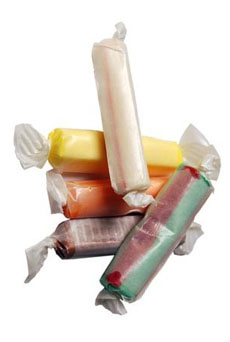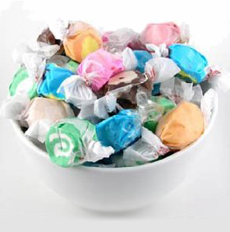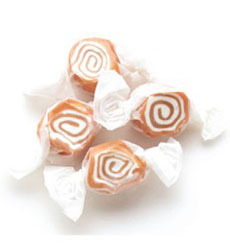

May 2006
Last Updated May 2014
|
 |
What Is Taffy?
Page 3: The ABCs Of Toffee
This is Page 3 of a four-page article on taffy. Here, what is taffy. Click on the black links below to visit other pages.
What Is Taffy?
According to FoodTimeline.org, the earliest written reference to “taffy” in the Oxford English Dictionary dates back to 1817; however, it is not what Americans think of as taffy but “...a treacle thickened by boiling and made into hard cakes.” John F. Mariani cites our familiar form of taffy in The Encyclopedia of American Food and Drink [Lebhar-Friedman:New York] 1999 (p. 321):
| |
Taffy. A confection made from sugar, butter, and flavorings that has a chewy texture obtained by twisting and pulling the cooked ingredients into elasticity. The British term for such candy is toffee or toffy, possibly from tafia, a cheap West Indian rum made from molasses and used originally to flavor candy. The Oxford English Dictionary notes that taffy...seems to refer to an older form of the candy. By the 1870s taffy bakes and taffy pulls, at which young people would gather to stretch the candy between them, had become social occasions. |
|
Earlier, in Listening To America, [Simon & Schuster:New York] 1982 (p. 138), Stuart Berg Flexner takes us back even earlier:
| |
In the 1840s...candy pulls became popular, being called taffy pulls by the late 1870s.... Taffy (British toffee) was simple to make, from molasses or brown sugar and butter, and the taffy pulls entertained young and old alike and were a suitable face-to-face pastime for courting couples. Salt water taffy became associated with the Atlantic City Boardwalk by the 1880s, and the box of neatly wrapped pastel rows of taffy became its typical souvenir. |
|
Taffy is a variation of soft toffee. Originally unflavored, molasses and vanilla were later added as flavorings; today, anything goes, from banana, chocolate, coffee, lemon and mint to hot chile. With the advent of fancy flavors, the taffy was also colored to match the flavor. In modern recipes, corn syrup may be added to prevent crystallization. The taffy is stretched or pulled for 20 minutes or so and rolled into ropes, then, cut into pieces no longer than two inches and wrapped in wax paper to keep it soft. |
|

Round taffy. Photo courtesy Sweet’s Taffy. |
Have A Taffy Pull
The taffy pull didn’t end with World War II: It’s alive and well.
- Here’s a charming recounting of the taffy pull when it was popular recreation for country folk, along with a recipe.
- If you want to have a modern taffy pull, here’s how to host a party.
Salt Water Taffy
No, there’s no “salt water” in the taffy, although water is required to make the product. There are a variety of stories about the history of Atlantic City’s famous salt water taffy, which originated in the 1880s (the first mention of “salt water taffy” in Atlantic City business directories in 1889). The most popular is that a storm flooded the shop of a taffy vendor, and when a customer came in he said he could only sell her “salt water taffy.”
Possibly more accurate is simply that the name evolved from creative young tourists. According to an account in Wikipedia, taffy maker Joseph Fralinger was standing at the taffy booth of David Bradley, whom the anecdotes credit with the “storm” story, and heard one young girl ask for “salt water taffy,” another ask for “ocean wave taffy” and a third ask for “sea foam taffy”. They were not referring to different flavors, but to the taffy from the ocean resort.
Taffy is a variation of soft toffee. Originally unflavored, molasses and vanilla were later added as flavorings; today, anything goes, from banana, chocolate, coffee, lemon and mint to hot chile. With the advent of fancy flavors, the taffy was also colored to match the flavor. In modern recipes, corn syrup may be added to prevent crystallization. The taffy is stretched or pulled for 20 minutes or so and rolled into ropes, then, cut into pieces no longer than two inches and wrapped in wax paper to keep it soft. |
|

Round taffy. Photo courtesy Wikimedia. |
Mr. Fralinger did recognize a concept when he heard it: He popularized the name “salt water taffy” by formally boxing it with that name and selling it as a souvenir of Atlantic City. The shops of Fralinger and his first major competitor, Enoch James (who made the taffy bite-size and less sticky) still operate stores on the Atlantic City Boardwalk.
Taffy is available in three shapes: bars the size of chocolate bars (and a jumbo bar often found at souvenir shops), individually-wrapped oblongs shown in the photo above, and rounds shown here. Bars tend to be harder and tougher to chew—“kid stuff.” Even with individually wrapped toffee, if you value your fillings, pinch a piece before you chew it. It should yield to pressure, like a ripe pear. Otherwise, you might want to remove the wax paper and nuke it for 3 seconds in the microwave. |
|

Caramel Taffy Swirls. Photo courtesy Sweets Taffy. |
Continue To Page 4: What Makes A Great Toffee
Go To The Article Index Above

|







